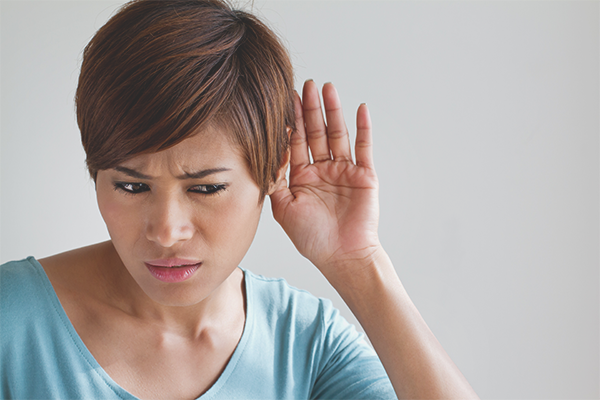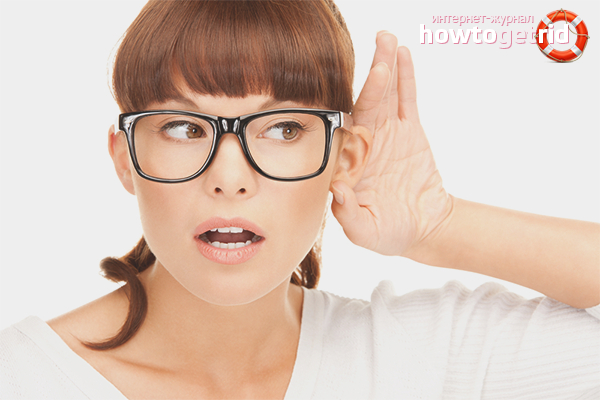The content of the article
Hearing loss is called a temporary or permanent hearing loss due to any reason. According to statistics, almost every inhabitant of the planet experiences episodes of temporary hearing loss at least once in their lives. Permanent hearing loss is more common in the elderly. However, sometimes persistent hearing loss occurs in younger people. Why does it arise and is it possible to get rid of it?
How do we hear?
In order to understand how hearing loss occurs, it is necessary to know how hearing is formed at all. Allocate the outer, inner and middle ear (first, second and third sections).
The first section is represented by the auricle, which passes into the cartilaginous, and then the bone ear canal. These sections are necessary in order to amplify sound waves. Then follows the eardrum (outer membrane), to which the elements of the second section are attached.
The second section has three small bones connected in series. They start to move when the sound hits the outer membrane and presses it inside. The movement of the stones is transmitted to the inner membrane, which separates the second division from the third.
The movement of the internal eardrum vibrates the fluid (perilymph and endolymph). These vibrations are transmitted to the receptors of the auditory nerve. The auditory nerve is the eighth pair of cranial nerves. It transmits the impulse from the auditory receptors to the temporal cortex. This is how our perception of sound waves is formed. Hearing loss can occur at any of the stages of its formation.
Types of pathology
Depending on the level at which the sound transmission decreases, several types of hearing loss are distinguished:
- Conductive It occurs when an external or middle ear is affected. In this case, the sound wave encounters an obstacle in its path and can no longer fully penetrate the inner ear. As a rule, such a hearing loss is either temporary or permanent, but is treatable through various correction methods.
- Neurosensory. In this case, the structures of the inner ear are affected (receptor apparatus of the eighth pair of FMN). In this case, the mechanical oscillations of the fluid of the inner ear do not become electrical impulses that must reach the cortex. Such hearing loss is rarely subject to correction.
- Mixed In this case, there are signs of both conductive and sensorineural hearing loss.
- Neural or cortical. It occurs when the auditory nerve itself or the structure of the temporal gyrus is affected. This type of hearing loss is not treatable.
Diagnosis of hearing loss otolaryngologist by using the device - an audiometer. In addition, various tuning forks and external examination of the auricle are used. All types of hearing loss, except neural treats otorhinolaryngologist. The neurological doctor is engaged in neurologist.
Causes of hearing loss
There are many reasons that can lead to hearing loss. Often there are the following:
- Clogging with sulfuric grease (plug). A special lubricant called sulfur is constantly produced in the ear canal. It is necessary to protect the ear pickup device.Normally, sulfur is removed from the ear on its own, but for some people this process is poorly developed. Then sulfur accumulates and forms a so-called cork. This plug blocks the ear canal and causes hearing loss.
- Damage to the outer membrane. This reason is quite common. The external eardrum can be injured as a result of improper cleaning of the ear canal, as well as blows and falls.
- Otitis. So called inflammation of one of the ear. The most common otitis media that occurs with SARS. At the same time, an exudate accumulates in the cavity of the middle ear, which interferes with the movement of the auditory ossicles, which causes hearing loss. In addition, the exudate can break through the external eardrum, which only exacerbates hearing loss.
- Damage to the receptor of the auditory nerve. This pathology occurs when exposed to many factors. For example, some viruses (measles, mumps, HIV) adversely affect the end of the auditory nerve, which causes hearing loss. Some drugs also have the same ototoxicity. Most of all to reduce hearing results from the use of aminoglycoside antibiotics (gentamicin).
- Congenital hearing loss. In this case, hearing loss arises due to underdevelopment of the structures of the sound-perceiving apparatus or intrauterine damage of the auditory nerve with toxic substances. For example, when a future mother uses alcohol, fetal alcohol-induced hearing loss occurs. Also adversely affecting the auditory nerve affects intrauterine infection with syphilis.
- Senile hearing loss. It occurs in the vast majority of people over 70 years. This is due to the coarsening of the tympanic membranes, the hardening of the auditory cavities and the decrease in receptor sensitivity to fluctuations in the fluid of the inner ear.
- Damage to cortical structures. In this case, the sound waves pass normally and even turn into electrical impulses, but these impulses do not reach the cortex and the person does not hear the sounds surrounding him. The reason for this may be strokes, injuries and tumors of the brain of the temporal localization.
Ways to improve hearing
The choice of the method of getting rid of hearing loss depends primarily on the cause of the cause. Methods for improving hearing may be as follows:
- Purification of the ear canal. This method will get rid of sulfuric plug. To do this, it is enough to drop 3% hydrogen peroxide into the ear canal, wait five minutes and clean it with a cotton swab.
- Tympanoplasty. So called plastic surgery to restore the eardrum. It is necessary in case of any types of damage to the latter.
- Otitis treatment. This type of treatment should be prescribed by a doctor. As a rule, treatment consists in the use of special drops, ingestion of antibiotics, and sometimes they also evacuate the exudate.
- Hearing aid. It is installed in the event that the receptors of the auditory nerve are damaged. This device is able to transform mechanical vibrations. At the moment there are many varieties of it.
- Electrostimulation. This type of physiotherapy is aimed at the treatment of neurosensory, neural and cortical hearing loss. In this case, there is a constant stimulation of the auditory nerve, which sometimes leads to an improvement in its functioning. Unfortunately, the method is not always effective.
- Physiotherapy. Aimed at improving the blood supply to the ear.To do this, close the ears with his hands, and then quickly pull back, make intensive chewing movements of the jaw, exhale with the mouth and nose closed.
Thus, we can conclude that there are many reasons for the development of hearing loss. The methods of its correction directly depend on the cause. It is worth remembering that the faster the hearing loss is diagnosed and the treatment is started, the more chances to restore hearing. It is recommended to consult a otolaryngologist immediately after hearing loss has occurred. The doctor will not only establish the type and causes of hearing changes, but also prescribe the correct therapy. Self-medication in this case can lead to permanent loss of hearing.
Video: how to improve hearing












To send